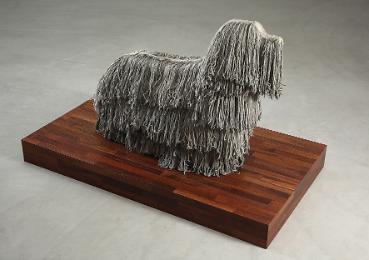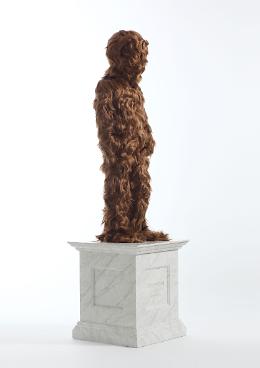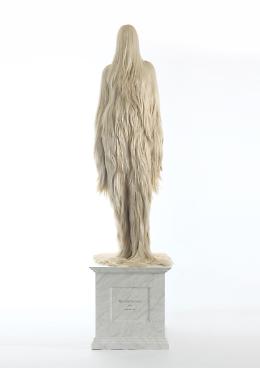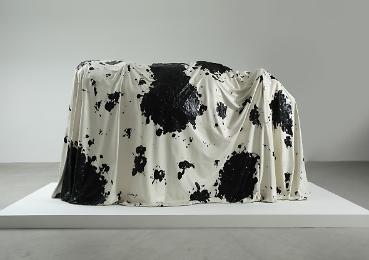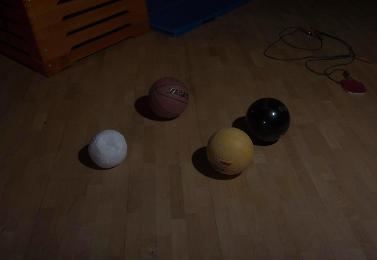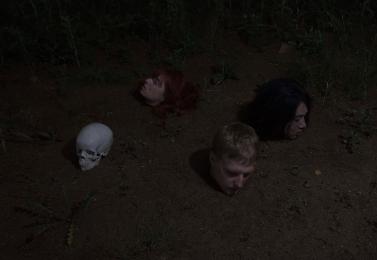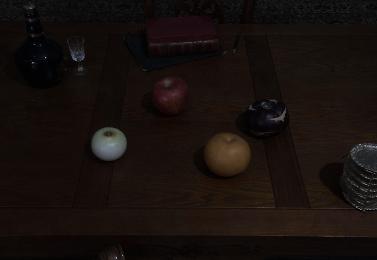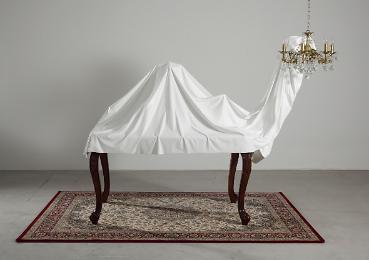박문희 개인전 <미지의 생명체들>
유기적이지 않은 유기체
이선영 / 미술평론가
박문희의 작품에는 인간과 동물, 그리고 자연이 풍부하게 나타난다. 그러나 그것들은 있는 그대로의 모습으로 재현되지는 않는다. 수수께끼처럼 한 겹, 또는 여러 겹으로 에워싸여 있다. 작가는 지시대상을 포기하지 않으면서도 그것을 투명하게 드러내려 하지 않는다. 그것을 보는 순간 ‘이것이구나’ 하면서 대상을 가상적으로 소유하는 대신에, ‘이게 뭔가’하는 추리력을 발동시켜야 한다. 이러한 간접적인 방식은 그가 생명체에 대한 탐구를 주제로 한다는 것에서 온다. 여러 사물의 복합체로 구성된 것으로 보이는 미지의 생명체들은 그것이 직관적으로 이해될 수 있는 단일한 대상이 아니라, 여러 관계의 조합으로 이루어졌음을 예시한다. 그의 작품은 단일한 물질로 만들어진 작품조차, 이것저것이 동원되어 짜 맞춰 진 설치물이라는 느낌을 준다. 여러 작품에 나타나는 포장 막 같은 형태는 내부와 외부 사이의 불일치를 조성한다.
박문희의 작품은 생명체를 대상으로 하지만 생명처럼 자연스럽게 발생한 것이 아니라, 구성된 것이며 관객은 재구성을 통해 작가가 제안한 인식론적 게임에 참여한다. 여기에서 관계란, 대상(동일성) 자체를 이루고 있는 이질성(타자) 간의 관계, 주체와 대상의 관계 등을 포함한다. 박문희의 작품은 유기체를 다루지만 유기적이지 않다. 그의 작업은 선택된 대상의 부재나 변형을 암시하는 장치들의 고안에 집중된다. 그것들은 영원히 풀리지 않는 수수께끼에 탐닉하기 위한 것이기 보다는, 탐구를 시작하고 이끌어나가는 유혹의 장치라 할 수 있다. 여기에서 모순과 역설어법은 자주 사용된다. 생명체를 대상으로 한다는 점 뿐 아니라, 때로 예술품은 자율적인 생명체로 고양되기도 한다. 그의 작품에서 생명은 자명한 출발이 아니라, 도달해야 할 미지의 대상이다. 사물은 사물을 연출하는 방식만큼이나 다양하게 인식될 수 있다. 그의 작품은 생명의 기원과 목적 같은 관념론적이고 신학적인 가설, 즉 대답될 수 없는 추상적 질문이 아니라, 생명체로 인지되기 위한 현실적 조건을 제시하려 한다.
예술작품이 진리로 가득 해야 한다는 강박관념은 예술이 가지고 있는 생생한 야생성을 거세한 채 관념론에 경도되곤 한다. 재현주의는 관념론과 예술이 결탁한 대표적인 예이다. 그러나 미니멀리즘 이후, 이념과 예술에서 몸과 사물로 방점을 찍어온 현대미술은 이러한 관념론적 방식을 지양한다. 그의 작품은 선험적 가정에 의해 중심과 주변의 합리적 관계를 명시하는 투명한 구조가 아니라, 시간을 두고 되풀이하여 해석해야 하는 불투명한 사물로 다가온다. 그것은 공시적 명료성이 아니라, 시간의 추이를 따르는 경험의 축적, 그 과정이 중요하다. 생명체 자체가 오랜 시간이 축적된 과정의 결과물이기에 시간성(temporality)이 요구되는 것이다. 시간성은 단칼에 베어진 듯 명료한 공간성과 달리, 불확실성(변수)을 늘린다. 그의 작품에서 무언가를 가리는 막은 대상과 주체 사이의 접면을 더욱 확장하고, 대상과의 관계망을 활성화시켜 결과적으로 유희의 공간을 만든다.
생명체는 소재일 뿐 아니라, 작품 자체가 작동하는 방식 또한 생명의 과정을 따른다. 박문희의 작품에서 생명체는 여러 구조들의 결절점 내지 교차점이 있으며, 결코 완결되어 있지 않다. 원래의 형태에 부가시켜 놓은 듯한 장치는 고정이 아닌 과정을 강조한다. 그것들은 사물의 윤곽과 굴곡을 다르게 형성하면서, 하나의 현실로 환원할 수 없는 편차와 간격을 만든다. 의미는 주체와 대상과의 완전한 일치가 아니라, 이러한 틈에서 발생한다. 표면에서 펼쳐지는 사건들이 있는 작가의 역설 어법은 하나의 방향이 아니라, 두 방향을 동시에 긍정한다. 그의 작품에서 활성화된 표면들은 지고한 합목적성, 본질적인 실재, 나아가 역사의 의미라는 이름으로 행해지는 동일자의 모델을 전복하는 것이다. 동일성에 근거하는 사변철학은 예술에 가까울 정도로 유연해진 현대철학에 의해 근본적으로 비판된다. 표상적 사고를 넘어서는 현대 예술은 현대의 철학이나 과학과 더불어 ‘야생적 존재로서의 세계를 복원’(메를로 퐁티)함으로서, 새로운 의미를 탄생시키는 효과적 방법론이 될 것이다.
Park, Munhee
The non-Organic Organism
Lee, Sun Young / Art Critic
People, animals, and nature richly populate Munhee Park’s works in an altered state; they dwell veiled manifold, like puzzles. Park refuses to neither surrender the slight clues nor transparently release their identity. Instead of recognizing the object as “being such and such,” and claiming virtual ownership immediately upon casting eyes upon the object, the viewer is encouraged to infer reasoning and ask “what could this be?” This indirect, circumnavigating detour of a method is Park’s underlying theme of enquiry into living organisms. Strange organisms that appear to be a conglomeration of several objects cannot be grasped intuitively as a singular object, but viewed as a combined illustration of multiple relationships. Even works created from a single substance gives the impression of eclecticism, and the “cover,” found on many of his works create discord between the interior and the exterior.
Although Park’s works appear to consider organisms as the object, they do not feel naturally occurring as life is, but rather contrived, beckoning the visitor to participate in an epistemic game proposed by his reconstruction. The scope of the term relationship covers the exchange between heterogenic(dissimilar) aspects that compose the object(homogenic), and also between the agent and the object. In this context, the artist’s works deal with organisms without being organic themselves. Park’s processes focus on the devices that infer an absence or transformation of the object in question. The devices are not indulgences to the unsolvable enigma, but a beckoning to exploration, where contradictions and paradoxes are commonplace. Park’s art is oriented on organisms, and sometimes even take the form of an organism with free will. In his work, life is not a self-evident place of departure, but an unknown destination to be sought. An object may be understood in ways as diverse as the means through which it can be expressed. Unanswerable abstractive questions like those revolving around the origin and purpose of life are not found in Park’s works. Suggested instead are realistic conditions necessary to be recognized as life.
The obsessive idea that art must resonate with verity may often lead to castration of art’s virily savage nature. Representationalism is a prime example of collusion between idealism and art. However, following the era of minimalism, modern art has drawn boundaries through body and object in ideology and art, rejecting this ideological method. His work is not of a transparent structure based on intuitive assumption that specifies a rational relationship between a center and its surroundings, but an obscure object that requires reiterative interpretation across multiple occasions. It is not the synchronic lucidity but the aggregation of experience in the course of time, in other words, the process. As organisms themselves are results of long aggregated processes, temporarily is an indispensable dimension. Temporality adds uncertainty(variables) in contrast to the clear-cut stroke of spatiality. The veils in Park’s works expand the tangent between the object and the agent, vivifying the relationship with the object and consequentially forming a space of amusement.
In Park’s art, organisms are not mere material, as the device of his work follows the processes of life. The way his organisms are displayed in his works show nodal points or a sort of intersection, which are open ended forgoing conclusion. The device emphasizes process, not status. It shifts and alters silhouette and lines, deviating and distancing disallowing the visitor’s return to a single reality. Meaning transpires not from perfect agreement between agent and object, but through the ambiguous space between. Park’s paradoxical figure of speech selects not a single direction, but gives acquiesce to both directions The surfaces roused in his works overturn the model of identity that manifest under expressions such as “highest teleonomy”, “fundamental existence”, and even “historical significance”. The flexible nature of modern philosophy nears that of art as it criticizes speculative philosophy rooted in the concept of identity. Transgressing representational thought, together with modern philosophy and science, modern art restores the world as savage beings(Merleau-Ponty), and will prove an effective methodology to the production of new meaning.

 작품을 클릭하시면 큰 화면으로 감상하실 수 있습니다.
작품을 클릭하시면 큰 화면으로 감상하실 수 있습니다.





